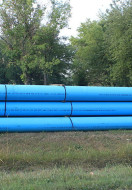Humans use mercury in a variety of manufacturing processes and products such as thermometers and fluorescent bulbs. If you improperly dispose of products with mercury in them, they may break and release mercury vapors which are harmful to human and ecological health.
- Dispose of used mercury-containing items properly.
- Clean up mercury spills properly and report them to the proper authorities when necessary.
What Never to do with a Mercury Spill
- Never use a vacuum cleaner to clean up mercury. The vacuum will put mercury into the air and increase exposure.
- Never use a broom to clean up mercury. It will break the mercury into smaller droplets and spread them.
- Never pour mercury down a drain. It may lodge in the plumbing and cause future problems during plumbing repairs. If discharged, it can cause pollution of the septic tank or sewage treatment plant.
- Never wash mercury-contaminated items in a washing machine. Mercury may contaminate the machine and/or pollute sewage.
- Never walk around if your shoes might be contaminated with mercury. Contaminated clothing can also spread mercury around.
What to Do if a Fluorescent Light Bulb Breaks
Compact fluorescent lights (CFL's) are lighting more homes than ever before, and EPA is encouraging Americans to use and recycle them safely. Carefully recycling CFLs prevents the release of mercury into the environment and allows for the reuse of glass, metals and other materials that make up fluorescent lights.
Flurescent Light Bulbs contain a very small amount of mercury sealed within the glass tubing. EPA recommends the following clean-up and disposal guidelines:
Before Clean-up: Ventilate the Room
- Have people and pets leave the room, and don't let anyone walk through the breakage area on their way out.
- Open a window and leave the room for 15 minutes or more.
- Shut off the central forced-air heating/air conditioning system, if you have one.
Clean-Up Steps for Hard Surfaces
- Carefully scoop up glass fragments and powder using stiff paper or cardboard and lace them in a glass jar with metal lid (such as a canning jar) or in a sealed plastic bag.
- Use sticky tape, such as duct tape, to pick up any remaining small glass fragments and powder.
- Wipe the area clean with damp paper towels or disposable wet wipes and place them in the glass jar or plastic bag.
- Do not use a vacuum or broom to clean up the broken bulb on hard surfaces.
Clean-Up Steps for Carpeting or Rug
- Carefully pick up glass fragments and place them in a glass jar with metal lid (such as a canning jar) or in a sealed plastic bag.
- Use sticky tape, such as duct tape, to pick up any remaining small glass fragments and powder.
- If vacuuming is needed after all visible materials are removed, vacuum the area where the bulb was broken.
- Remove the vacuum bag (or empty and wipe the canister), and put the bag or vacuum debris in a sealed plastic bag.
Future Cleaning of Carpeting or Rug: Ventilate the Room During and After Vacuuming
The next several times you vacuum, shut off the central forced-air heating/air conditioning system and open a window prior to vacuuming.
Keep the central heating/air conditioning system shut off and the window open for at least 15 minutes after vacuujming is completed.







